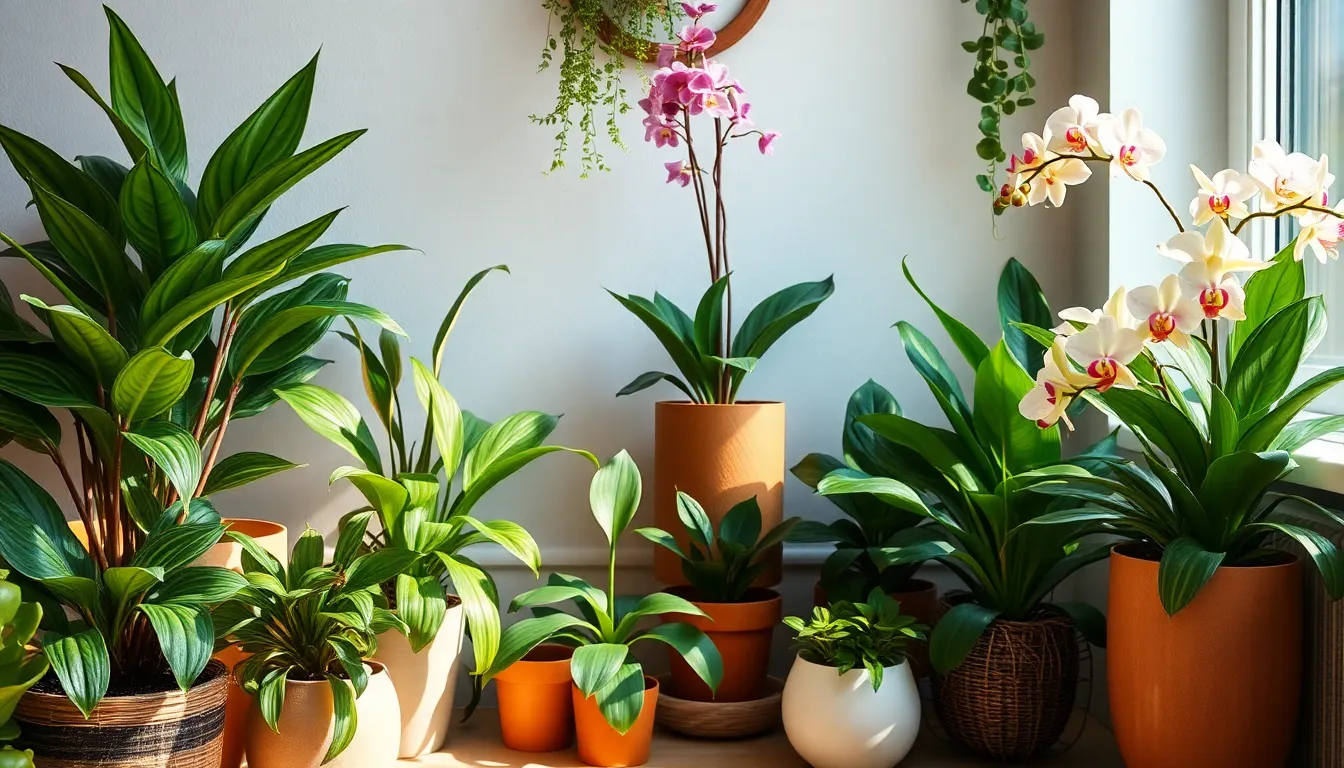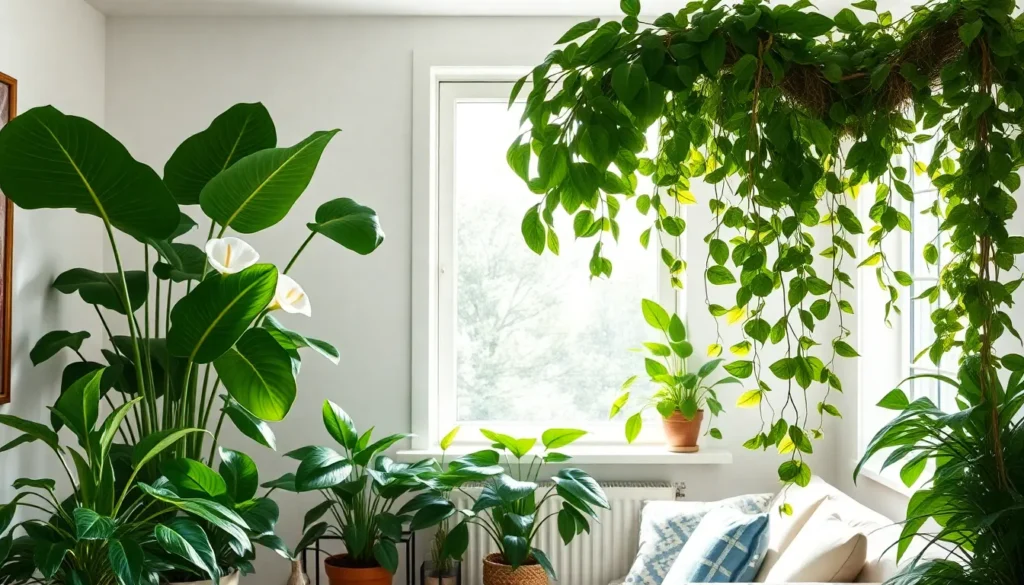Table of Contents
ToggleHouse plants are the ultimate home accessory, turning dull spaces into vibrant jungles. Whether you’re a seasoned plant parent or just looking to add a touch of green to your life, there’s a perfect plant waiting for you. From the low-maintenance succulents that practically thrive on neglect to the dramatic monstera that’ll have your friends green with envy, the options are endless.
Types of House Plants
House plants vary greatly in appearance, care requirements, and benefits. Each type offers unique advantages that suit different lifestyles and preferences.
Succulents are popular for their low maintenance needs. These plants thrive in dry conditions, requiring infrequent watering. An array of shapes and colors enhances indoor spaces.
Ferns add lush greenery and decorative appeal. They typically prefer humid environments, making them suitable for bathrooms or kitchens. Regular misting helps maintain their vibrant leaves.
Cacti provide a distinctive aesthetic with their unique forms. These hardy plants also thrive in dry conditions and require minimal care. Ideal for beginners, cacti flourish in bright sunlight.
Spider plants are known for their air-purifying qualities. Their cascading leaves and small offshoots make them visually striking. They adapt well to various light conditions and need moderate watering.
Pothos is another favorite, praised for its trailing growth and versatility. Easy to propagate, this plant can thrive in low light and requires infrequent watering. Varieties include variegated forms that add visual interest.
Fiddle leaf figs stand out due to their large, glossy leaves. These plants need bright, indirect light and benefits from regular watering. Their bold presence makes a statement in any room.
Peace lilies bloom beautiful white flowers and enhance indoor air quality. They prefer low to moderate light and require consistent moisture. Their elegance and ease make them a common choice.
Rubber plants feature thick, dark green leaves and contribute to a modern aesthetic. They tolerate low light and need less frequent watering than many plants. Over time, rubber plants can grow quite tall, making them eye-catching focal points.
These various types of house plants cater to different preferences, ensuring that everyone can find the perfect addition to their decor.
Popular Indoor Plants

Many indoor plants thrive in specific conditions, enhancing any living space. Each type offers distinct characteristics.
Low-Light Plants
Low-light plants excel in subtler lighting, making them perfect for homes with limited natural sunlight. Snake plants are resilient and adaptable, tolerating neglect. ZZ plants also thrive in low light and require minimal water, adding a touch of elegance to rooms. Pothos demonstrates remarkable versatility, growing easily in various conditions with cascading vines. Lastly, cast iron plants are hardy and resist poor conditions, making them suitable for beginners and seasoned plant enthusiasts alike.
Flowering Plants
Flowering plants bring vibrant colors and lively energy to indoor spaces. African violets bloom beautifully throughout the year, introducing rich hues and delicate petals. Peace lilies offer stunning, white flowers along with air-purifying benefits, enhancing aesthetics and health. Orchids are known for their exotic appeal, with diverse varieties adding elegance and sophistication. Christmas cacti display dazzling blooms in winter, providing seasonal charm. Lastly, begonias variety showcases striking flowers and leaves, ensuring interest in any décor.
Foliage Plants
Foliage plants bring vibrant greenery and texture to indoor spaces. They range from low-maintenance varieties to those requiring specific care, making them appealing to many plant enthusiasts.
Succulents
Succulents thrive in dry environments with minimal water. Their fleshy leaves store moisture, allowing them to survive drought conditions. Popular types, such as Echeveria and Haworthia, display a variety of shapes and colors. Easy to care for, succulents suit beginners, fitting well on windowsills or desks. With their unique forms, they create visual interest without demanding much attention.
Ferns
Ferns enrich interiors with their lush foliage and intricate leaf patterns. They prefer humid conditions and indirect light, making bathrooms or kitchens ideal locations. Boston ferns and maidenhair ferns are commonly chosen for their beauty and air-purifying qualities. Regular misting or humidity trays provide the moisture they need. These plants offer a refreshing aesthetic and thrive in environments that may be less suitable for other houseplants.
Air-Purifying Plants
Air-purifying plants enhance indoor air quality while adding beauty to home environments. Two popular options include the snake plant and peace lily, each offering unique benefits.
Snake Plant
Snake plants, known for their upright leaves, are among the easiest plants to care for. They thrive in low light and require minimal watering, making them ideal for any home. NASA recognizes snake plants for their ability to filter formaldehyde, xylene, and toluene from the air. Sturdy and long-lasting, these plants tolerate neglect, ensuring they remain a resilient choice for plant enthusiasts. Their architectural shape adds a striking element to decor, elevating any interior space.
Peace Lily
Peace lilies stand out for their graceful blooms and air-purifying qualities. They flourish in low light settings, responding well to indirect sunlight. Peace lilies filter out harmful pollutants like ammonia and benzene, improving indoor air quality significantly. These plants indicate when they need watering by drooping slightly, making care straightforward. Their elegant white flowers contrast beautifully with dark green leaves, bringing a touch of serenity to any living space.
Care Tips for House Plants
Caring for house plants involves understanding specific needs to ensure healthy growth and long-lasting beauty. Implementing proper care techniques enhances both decor and plant vitality.
Watering Guidelines
Watering practices vary among house plants. Most plants thrive with soil kept moderately moist, not soggy. Check the top inch of soil; if dry, it’s time to water. Succulents, like Echeveria, require less frequent watering due to their drought tolerance. In contrast, ferns prefer consistently moist soil and should be watered more often. Overwatering is a common issue; ensure proper drainage to prevent root rot. Use room temperature water to avoid shocking the roots. Be mindful of seasonal changes, as plants typically require less water during winter months.
Light Requirements
Light requirements differ significantly among plant species. Snake plants and ZZ plants excel in low-light areas, making them excellent choices for dim rooms. In contrast, flowering plants, such as African violets and orchids, thrive in bright, indirect sunlight. Place these plants near east-facing windows for optimal growth. Moreover, ferns appreciate filtered light and should avoid direct sun exposure. Different plants may adapt to varying light levels, so observe their growth patterns closely. Adjustments in light can often enhance their appearance and health over time.
House plants bring life and vibrancy to any home while offering a variety of benefits. With options ranging from low-maintenance succulents to stunning fiddle leaf figs there’s a plant for every lifestyle and aesthetic preference. The right choice can enhance decor and improve indoor air quality making spaces more inviting and healthier.
By understanding the unique needs and characteristics of each plant type individuals can create a thriving indoor garden that reflects their personal style. Whether it’s the elegance of a peace lily or the resilience of a snake plant house plants are more than just decor; they’re companions that contribute to a more pleasant living environment.







